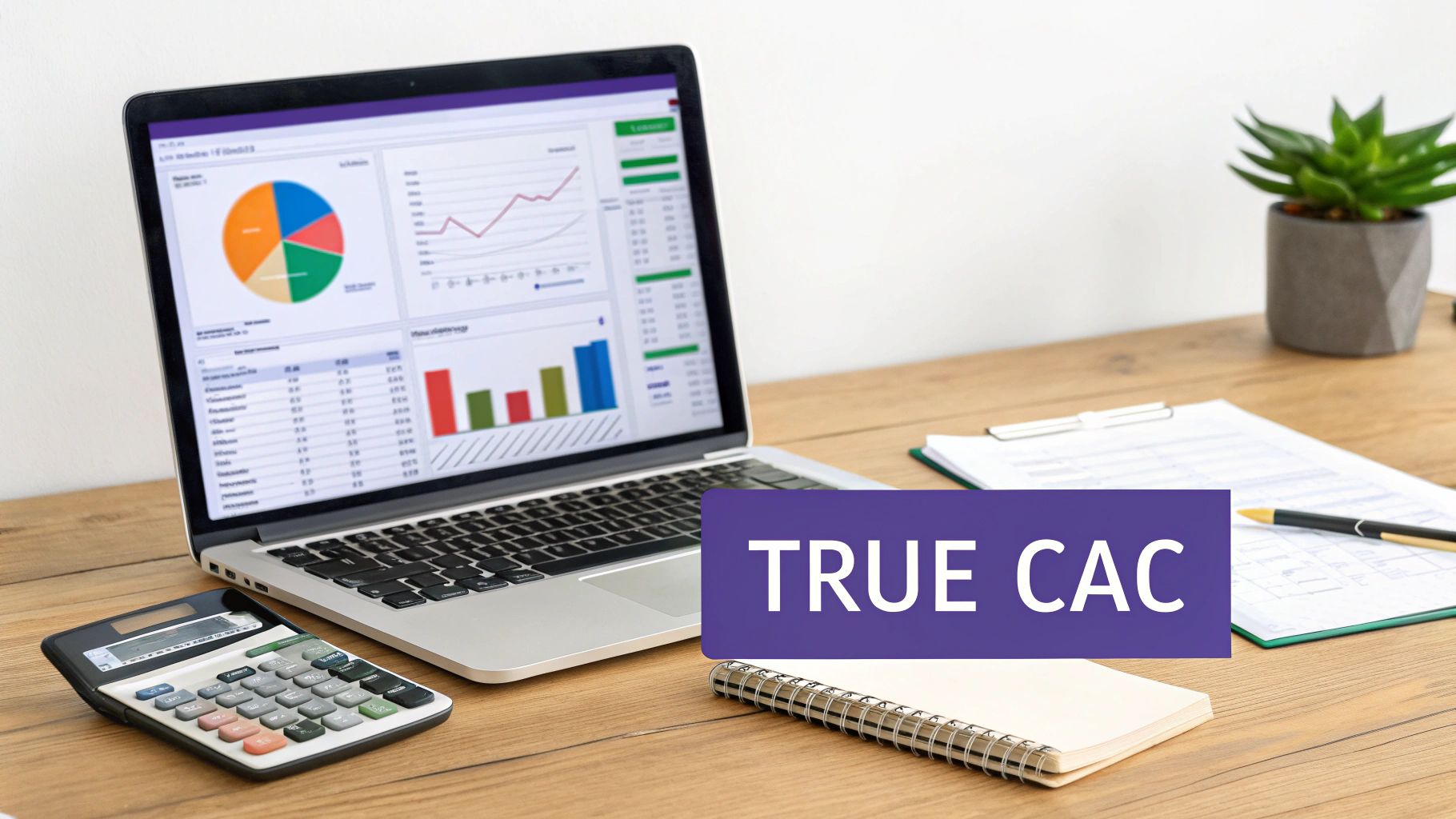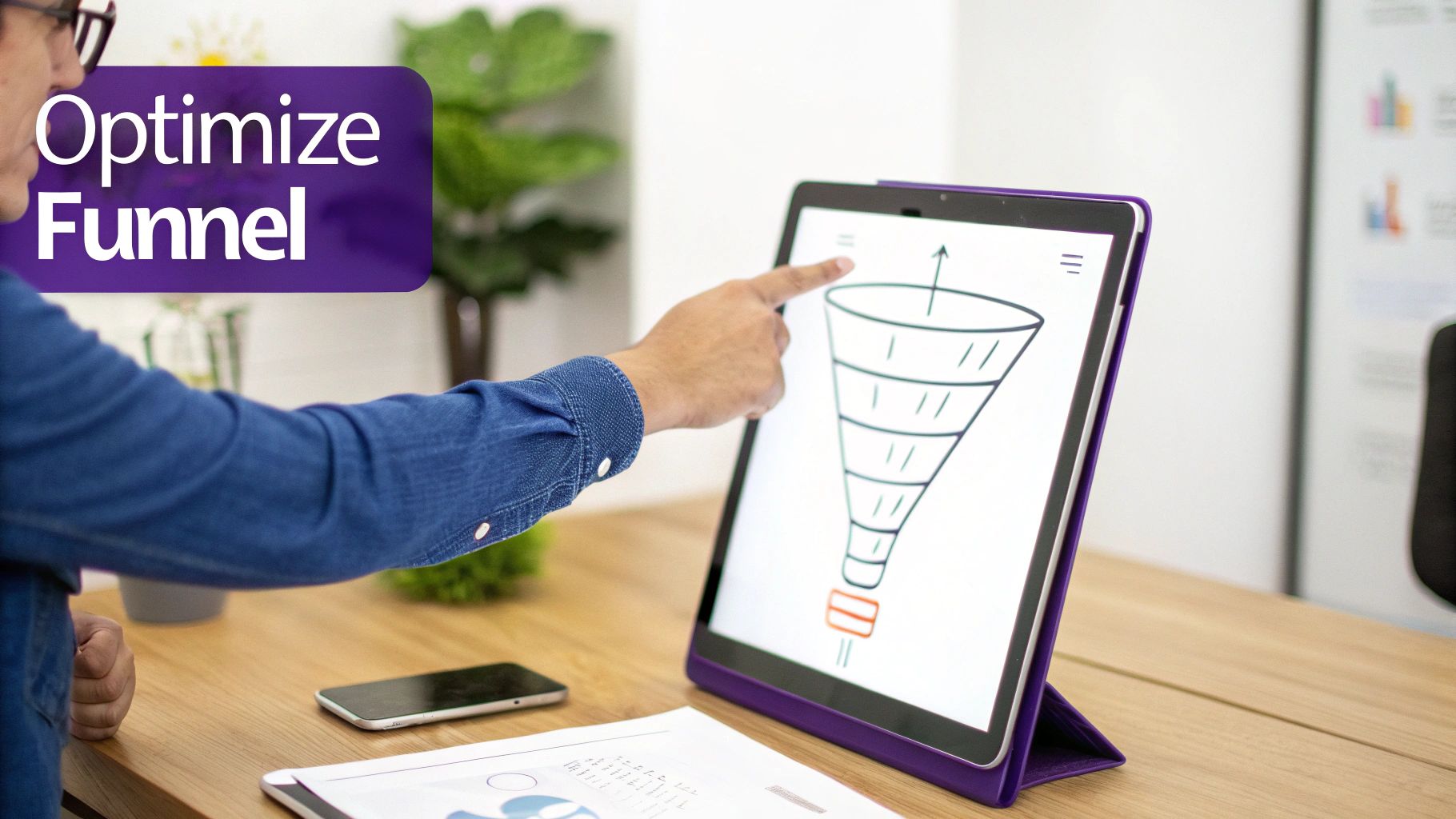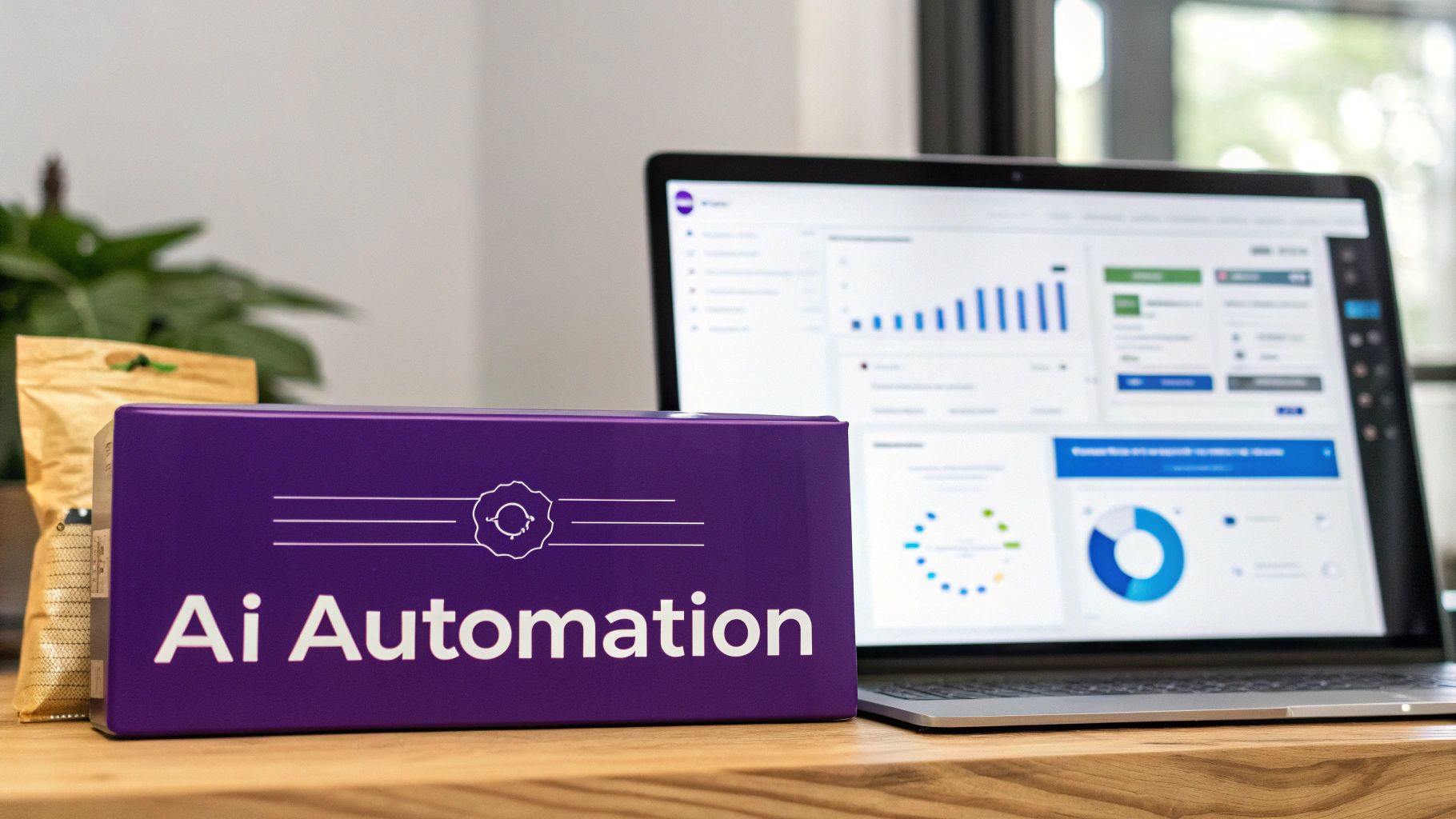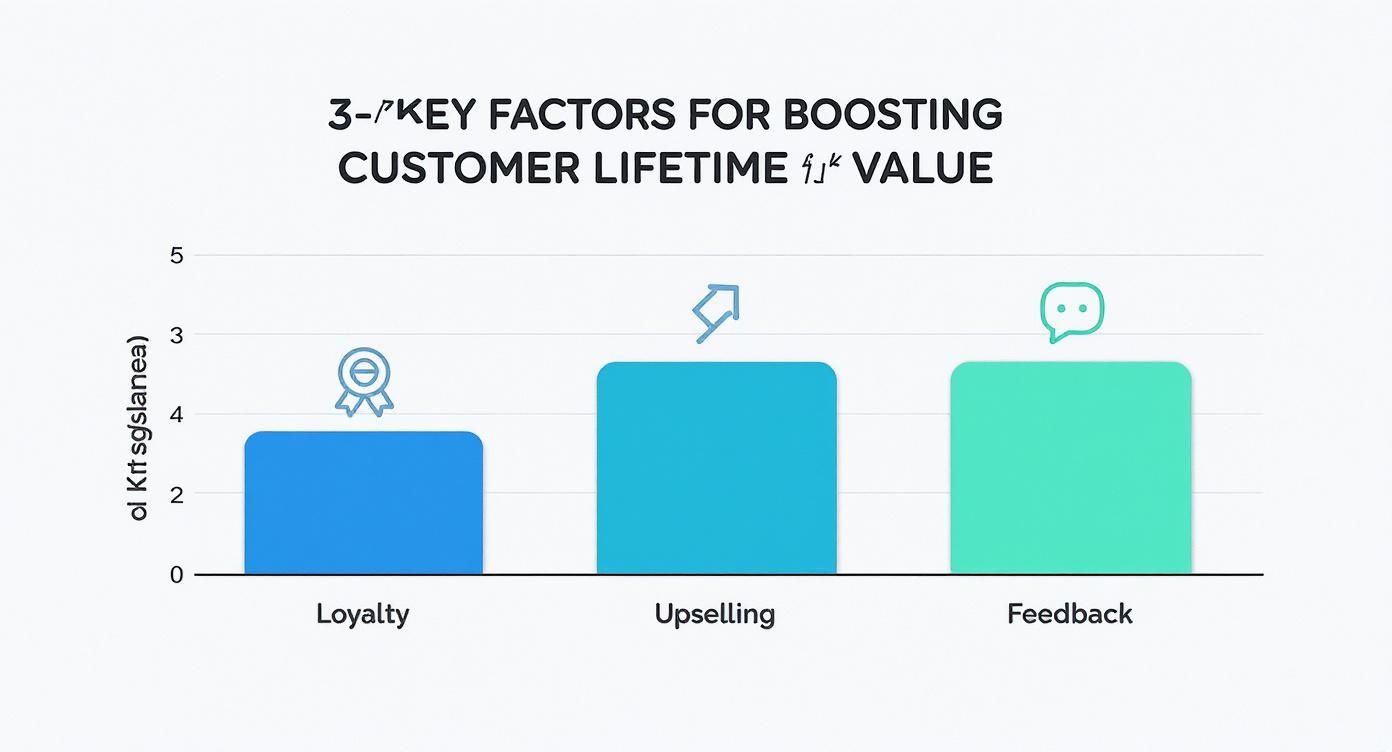Cutting your customer acquisition cost boils down to a three-pronged attack: fine-tuning your marketing channels, nailing your conversion rates, and using smart automation to do the heavy lifting. The goal isn't just about spending less; it's about getting more efficient and keeping the customers you already have.

Before you can even think about reducing your customer acquisition cost, you have to know what you’re really spending. I’ve seen so many businesses fall into the trap of using a dangerously simple formula—usually just dividing total ad spend by the number of new customers.
That approach gives you a skewed, incomplete picture of your business's health.
A true Customer Acquisition Cost (CAC) calculation goes much deeper. It needs to account for every single dollar spent on the hunt for new customers, which includes a lot of costs that are easy to overlook.
Think about everything that goes into your acquisition efforts:
If you skip these fully-loaded costs, you're flying blind. You can't make smart, strategic decisions about your budget and growth when your foundational data is wrong.
Getting a handle on your real CAC isn't just a "nice-to-have" metric anymore; it's a necessity. Markets are getting more crowded, and digital ad space is a battlefield. Naturally, the price of getting a potential customer's attention is shooting up.
The global average Customer Acquisition Cost has jumped from roughly $9 per customer back in 2013 to a projected $29 by 2025. That’s a massive increase, and it shows just how much harder—and more expensive—it’s become to acquire customers.
This trend forces businesses to get smarter and more efficient with every dollar. Knowing your true CAC is the first step toward building a growth model that can actually last. For an e-commerce business, for example, a deep dive into understanding Cost Per Acquisition (CPA) on Amazon can reveal channel-specific insights that make or break profitability.
Before we dive into the specific strategies, let’s quickly frame the core pillars that will guide our efforts to lower CAC. These are the foundational areas where focused improvements will yield the most significant results.
Each of these pillars works together to create a more efficient and sustainable customer acquisition engine. Now, let's look at a practical example of why the details matter so much.
Let’s put this into perspective with a quick scenario.
Imagine a direct-to-consumer (DTC) skincare brand spends $20,000 on Facebook ads in a month and brings in 500 new customers. At a glance, their CAC looks to be $40 ($20,000 / 500). Not too bad, right?
But wait. We forgot the fully-loaded costs:
Suddenly, the total acquisition spend isn't $20,000—it's $32,000. When you divide that by the same 500 customers, the brand’s true CAC is actually $64.
That’s a 60% increase, a number that completely changes the financial story. Knowing the accurate figure is what allows the brand to set realistic budgets and double down on strategies that deliver a real return.

If your marketing funnel is leaking, you're not just losing leads—you're actively burning cash. Every potential customer that drops off adds to your acquisition cost, making it absolutely critical to plug those holes. The first step is to get a clear picture of the entire customer journey, from that initial spark of awareness all the way through to the final purchase. This map will show you exactly where people are getting stuck or losing interest.
Forget the old-school, linear A-to-B funnel. The modern customer journey is a winding road. People bounce between TikTok videos, user reviews, and influencer posts long before they ever think about visiting your website. To get a real handle on your acquisition costs, you need to understand how to calculate the costs across this complex web of interactions. Optimizing every touchpoint is how you start to see real improvements in conversion and, ultimately, a lower CAC.
Once you’ve mapped out the journey, your analytics tools are where the real detective work begins. You're hunting for clues—things like pages with shockingly high exit rates or stages where a huge chunk of your audience just disappears.
A classic example I see all the time is the pricing page. I worked with a SaaS company that was stumped by a massive drop-off right there. They were attracting high-intent visitors, only to lose them at the final hurdle.
So, we started A/B testing the page with a few simple hypotheses:
The results were eye-opening. The combination of the simplified layout and the "Request a Demo" CTA was the clear winner. This small set of changes drove a 20% increase in demo requests, effectively lowering their CAC by turning traffic they’d already paid for into solid leads.
Think about your own online shopping habits. How many times have you abandoned a cart because the checkout process was just too much work? Friction is the ultimate conversion killer. Every unnecessary form field, every unexpected step, is another reason for someone to walk away.
Your goal should be to make buying from you as effortless as possible. A complicated checkout process can feel like you're asking customers to do your work for you, which is a surefire way to lose a sale.
Put yourself in your customer’s shoes and walk through your own checkout flow. Are you forcing them to create an account? Do you surprise them with shipping costs at the very last second? Each of these obstacles is an invitation to abandon the cart.
Just because someone leaves your site doesn't mean they're gone for good. Life happens. People get distracted, or maybe they just weren't quite ready to pull the trigger on their first visit. This is precisely where a smart retargeting strategy comes in.
By using tracking pixels, you can gently remind people about the products they viewed or the items they left in their cart. A well-timed, targeted ad that pops up in their social feed can be incredibly effective. Sometimes, a small nudge—like a discount code or a free shipping offer—is all it takes to bring them back to finish what they started. It's one of the most cost-effective tactics out there because you're focusing your budget on a warm audience that has already shown they're interested.

One of the most direct ways to get your customer acquisition cost under control is to let technology do the heavy lifting. It's not about throwing more money at the problem; it’s about making your acquisition efforts smarter and far more precise. When you automate repetitive tasks and use AI to crunch the data, your team is freed up to focus on big-picture strategy.
This isn't about replacing your team; it's about giving them superpowers. AI and automation are brilliant at handling the mind-numbing, data-intensive work that slows humans down. This allows your marketers to get back to being creative and strategic, leading to a much more efficient acquisition engine and, ultimately, lower costs.
Chasing the wrong audience is one of the most expensive mistakes you can make in marketing. AI-powered predictive analytics tools are designed to stop this. They dig through your existing customer data to pinpoint the exact traits and behaviors that define your most valuable customers.
Think about an e-commerce brand that sells outdoor gear. An AI model could sift through their purchase history and uncover that customers who buy a specific type of hiking boot and live in a certain region have a 3x higher lifetime value. Suddenly, the marketing team has a crystal-clear profile to work with. They can build lookalike audiences for ad campaigns, ensuring their budget is spent almost exclusively on prospects who look just like their best customers.
This kind of laser-focused targeting means you stop wasting ad spend on people who will never buy. It’s a surefire way to drive down your CAC right from the get-go.
The real power of AI in marketing isn't just about automation. It's the ability to make incredibly accurate predictions. You stop guessing who your best customers are and start knowing—and that’s a complete game-changer for your budget.
We’ve all seen them: the generic, one-size-fits-all email blasts that immediately get deleted. They’re a fast track to a depleted budget with very little to show for it. Today's marketing automation platforms, however, let you build sophisticated, personalized sequences that react to what a user actually does.
Let's take a SaaS company trying to convert free trial users into paying subscribers. Instead of sending the same five-email sequence to everyone, they can create dynamic journeys that adapt on the fly:
Each touchpoint is perfectly timed and highly relevant, which naturally increases the odds of conversion—all without a single person on your team having to lift a finger. This level of personalization at scale makes every marketing dollar work harder, directly lowering your acquisition costs while building a much stronger connection with potential customers.
If you're only focused on finding new customers, you're constantly trying to fill a leaky bucket. It's an exhausting, expensive cycle. A much smarter, more sustainable way to get your customer acquisition cost under control is to get more value from the customers you’ve already won over.
When you shift your energy from pure acquisition to building real loyalty, you increase your Customer Lifetime Value (CLV). Think about it: a high CLV makes that initial acquisition cost feel like a small, smart investment. A customer who comes back again and again over the years makes that first ad spend look like an absolute bargain. This is where you gain a real competitive edge, because it gives you the breathing room to spend what's necessary to attract the right kind of customers in the first place.
A good loyalty program is so much more than a digital punch card. It's a direct channel to your most valuable customers, making them feel seen and giving them a solid reason to stick with you instead of jumping to a competitor. And let's not forget, these are the people who will sing your praises. With 95% of customers reading reviews before they even think about buying, your loyal fans are your most powerful marketing asset.
Don't just settle for a generic "buy ten, get one free" offer. Get creative. A tiered system can work wonders, unlocking better perks as customers engage more.
Consider offering things like:
It’s these kinds of touches that build a real connection, moving beyond the transaction and turning casual buyers into genuine advocates for your brand.
One of the most direct ways to increase CLV is to simply increase the average order value. The trick is to make your upsells and cross-sells feel genuinely helpful, not like a pushy sales tactic. You have to get inside your customer's head and anticipate what they’ll need next.
Let's say someone just bought a high-end camera from your online shop. Your job isn't done once the receipt is sent. That's your opening. Instead of silence, you could kick off an email sequence that provides real value.
Suddenly, you're not just a retailer; you're a trusted expert. The upsell feels like a natural and helpful next step on their journey.
Don't just sell products; sell outcomes. Show customers how complementary products can help them achieve their goals, and the upsell will feel like a helpful suggestion rather than a sales pitch. This mindset shift is crucial for organically increasing customer lifetime value.
At the end of the day, nothing builds loyalty faster than making your customers feel like you actually get them. Use the data you have to create a truly personal experience. A subscription box service that uses customer feedback to tweak and perfect future boxes is a brilliant example of this in action.
When a customer sees that their feedback directly shaped their next delivery, they feel heard and valued. It’s a simple act, but it can skyrocket your retention rates. This transforms a basic transaction into a genuine partnership, making it incredibly difficult for a competitor to turn their head. That initial acquisition cost? It just paid for itself many times over.
Spreading your marketing budget thin across every channel out there is one of the fastest ways to inflate your customer acquisition cost. The goal isn't to be everywhere; it's to be in the right places, making the biggest splash. A smart, focused channel strategy is all about figuring out what's actually moving the needle and then putting your money where it counts.
To do this, you have to get your hands dirty with the data. I'm not talking about surface-level vanity metrics like clicks or impressions. You need to be tracking CAC, conversion rates, and even Customer Lifetime Value (CLV) for every single channel you're using. That’s where the real insights are hiding.
Treat your marketing channels like a portfolio of investments. Some are going to be your star performers, delivering steady returns, while others are just tying up your capital with little to show for it. The job is to spot the winners and double down.
I once worked with a B2B software company that was pouring money into paid social media ads. On the surface, things looked okay—they were generating plenty of leads. But once we dug into the numbers, a completely different picture emerged. We found that leads from organic search and industry-specific webinars had a CAC that was nearly 70% lower than leads from their social campaigns. Even better, those customers stuck around longer and had a much higher CLV.
Armed with that data, they made a tough but necessary call:
The impact was immediate. Within a single quarter, their overall CAC dropped significantly. They stopped overpaying for low-intent leads and started attracting prospects who were actively searching for the exact solution they offered.
Don't be afraid to pull the plug on a channel that isn't performing, no matter how popular it seems. Your data, not industry buzz, should be making the decisions.
While your competitors are locked in a bidding war over the same expensive keywords and crowded social media feeds, there’s a huge opportunity in the channels they’re ignoring. Think about niche forums, specialized industry newsletters, or private community groups where your ideal customers are hanging out. The cost to get in front of these audiences is usually a fraction of the big platforms, and the people there are far more engaged.
For instance, a business selling eco-friendly pet supplies could get incredible results by sponsoring a small but beloved podcast for veterinarians. Or they could run an ad in a regional newsletter for passionate pet owners. The total reach might be smaller, but the level of trust and relevance is off the charts, making for a much more efficient path to a sale.
Focusing on strategies that build loyalty, encourage customers to buy more over time, and provide you with crucial feedback can dramatically improve your customer lifetime value.

This visual really drives home how a multi-pronged approach is what it takes to get more value from your customers, which helps offset that initial acquisition spend. By fine-tuning your channel strategy and maximizing the value of every customer, you build a powerful growth engine that doesn't constantly demand a bigger and bigger marketing budget.
You're not alone. When you start digging into customer acquisition costs, a lot of questions pop up. Let's tackle some of the most common ones I hear from teams trying to get their acquisition spending under control.
This is the million-dollar question, isn't it? But there's no single magic number. A "good" CAC is completely dependent on your business.
The real metric to watch is your Customer Lifetime Value (CLV) to CAC ratio. A healthy, sustainable business usually sits around a 3:1 ratio. This means for every dollar you put into acquiring a customer, you're getting three dollars back over their lifetime.
If you’re at 1:1, you’re essentially breaking even on each new customer, which is a dangerous place to be. On the flip side, a 5:1 ratio might sound amazing, but it could be a sign that you’re not spending enough on growth and are missing out on scaling opportunities. The goal is to find your own sustainable sweet spot.
Patience is key, but the timeline really depends on what you're doing.
If I had to pick just one, it would be focusing on your conversion rate. It's the most powerful lever you can pull.
Think of it this way: if you can double your conversion rate, you've essentially cut your CAC in half without spending a single extra dollar on traffic. You're just getting more out of the visitors you already have.
Conversion rate optimization (CRO) is all about maximizing the value of your existing traffic. Small changes to your website’s user experience, clarifying your call-to-action, or improving your landing page copy can bring surprisingly big wins. It's often the highest-impact place to start.
I always tell people to find the biggest leaks in their marketing funnel first. Where are you losing people? Plug those holes. A few targeted improvements at those critical drop-off points will almost always lead to the most dramatic cost savings.
Ready to slash your acquisition costs with intelligent automation? Upcraft's conversational AI agents engage leads 5x more effectively than traditional methods, turning dormant contacts into valuable meetings. Discover how we can help you grow more efficiently.
Enter your contact information and Archer will start a conversation with you via text message.